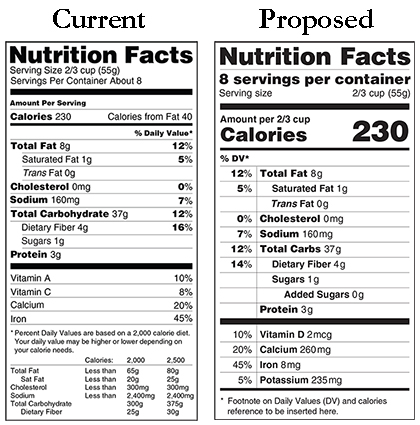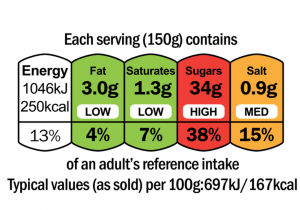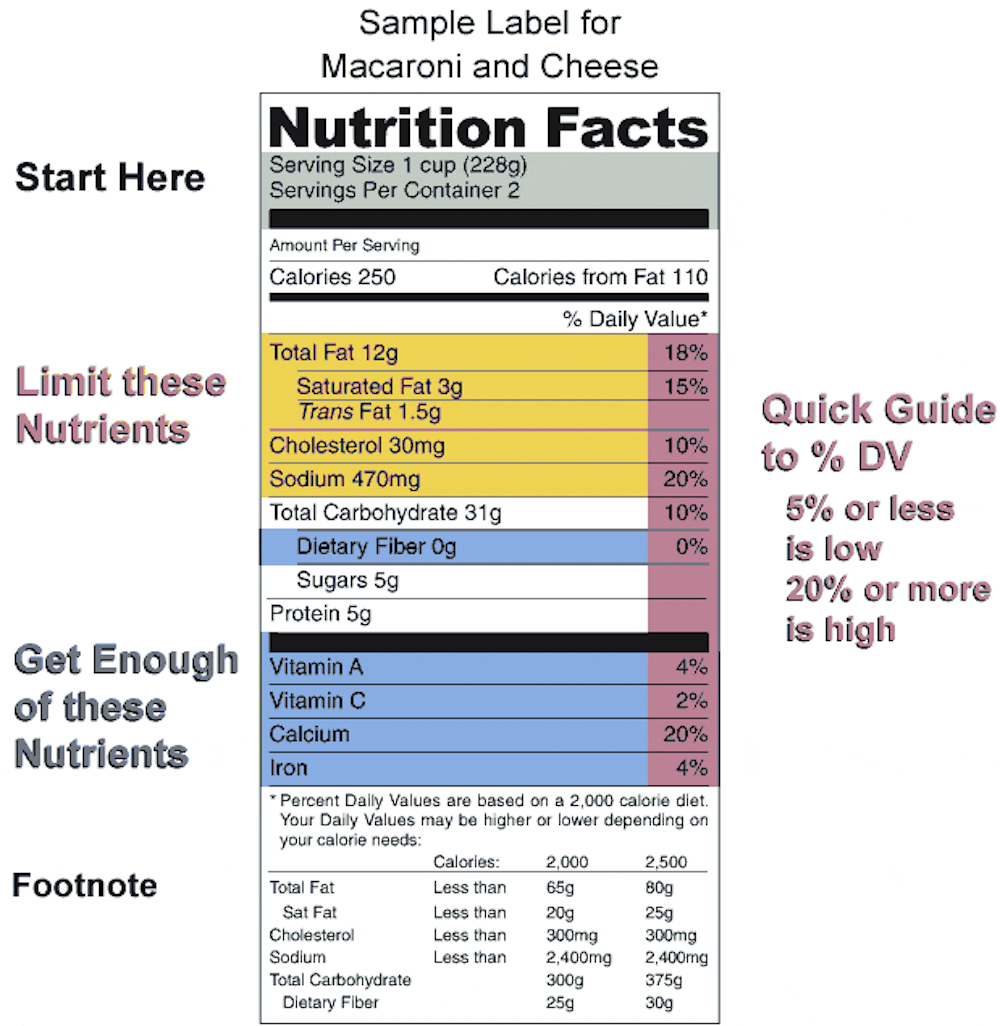40 kcal on food labels
This is why calorie content is always listed in 'kcals' - Cosmopolitan So that's where the 'k' comes in - it stands for 'kilocalories'. For every 1 'kcal' measure, you can assume you're actually counting 1,000 scientific calories, which sounds pretty scary if you... › dog-food-calculatorDog Food Calculator – Dognutrition.com Here’s a very basic made up example: Using the image above (1 cup, or 100 grams, provides 348 kcal). If your dog required 696 kcal per day, you’d simply feed them 2 cups of food a day. If your dog required 696 kcal per day, you’d simply feed them 2 cups of food a day.
Why are the calories in a nutrition label displayed in Kcal and ... - Quora Are calorie labels true? Not exactly. They can be as much as 20% off since some companies wants their products to appear "low calories." Each gram of Fat is 9 calories. Their fairly accurate with their labelings but some products you buy from the grocery store are probably 30-80 calories off. Protein bars especially. Your response is private

Kcal on food labels
en.wikipedia.org › wiki › Food_energyFood energy - Wikipedia Many governments require food manufacturers to label the energy content of their products, to help consumers control their energy intake. To facilitate evaluation by consumers, food energy values (and other nutritional properties) in package labels or tables are often quoted for convenient amounts of the food, rather than per gram or kilogram; such as in "calories per serving" or "kcal per 100 ... › nutrition › kcal-vs-caloriesKcal vs. Calories: Differences and How to Convert - Healthline Mar 08, 2021 · When it comes to nutrition and exercise, kilocalories (kcal) and calories equal the same amount of energy. Calories may also be expressed as kilojoules (kJ), with one calorie or kcal equaling 4.18 kJ. › sites › defaultNUTRITION LABELLING INFORMATION - Food Standards Agency 100g/ml of food. • Energy must be displayed as kJ/kcal. • Information must be displayed in this order in tabular format (if space on the label does not allow for tabular format then linear format is permitted). • of which sugarsIf the product contains no added salt a statement indicating 'naturally occurring
Kcal on food labels. Reading Cat Food Labels: Ingredients, Nutrition, and More - WebMD Guaranteed analysis: States the minimum or maximum amount of certain nutrients, including protein, fat, and fiber. Nutrients are different from ingredients. Feeding directions: Explains how to feed the product to the cat. Such directions are to be considered general guidelines, not rules. Ask your veterinarian for specific instructions. nutritiondata.self.comSELF Nutrition Data | Food Facts, Information & Calorie ... The Caloric Ratio Pyramid™ The Caloric Ratio Pyramid appears in every ND analysis, and also on ND's Total Consumption report. This symbol lets you see at a glance how the Calories in the food are distributed, and can help you determine if the food aligns with common macronutrient-based diet plans, such as low-carb (e.g Atkins™ or South Beach™), low-fat, high-protein, or Zone™. Reading Food Labels (for Parents) - Nemours KidsHealth The number of calories that's listed on the food label indicates how many calories are in one serving. Percent Daily Values Percent daily value is most useful for seeing whether a food is high or low in nutrients: A food with 5% or less of a nutrient is low in that nutrient. A food with 10%-19% of a nutrient is a good source of that nutrient. Learn How the Nutrition Facts Label Can Help You Improve Your Health That means if you consume 2,000 calories in a day, added sugars should account for no more than 200 calories. Read the Nutrition Facts labels on your packaged food and drinks to keep track of sugars, fats, protein, and other nutrients. Most sodium we consume is from salt, and salt is commonly in processed foods.
Cat Food Labels COMPLETE GUIDE - Jess Caticles There are 4 crucial steps to reading cat food labels properly. Product name rules Ingredients list Guaranteed analysis Nutritional adequacy statement And a bonus: the manufacturer. Product name rules The product name rule tells us how much of the named ingredient is in the product. This could range from 0% minimum requirement to 95%. The Science Behind Calories and Nutrition Facts Labels The calorie number we see on food labels refers to a kilocalorie (kcal), which is also known as a large calorie or a food calorie. A kilocalorie is 1 000 calories. One kilocalorie is the amount of energy it takes to heat one kilogram of water one degree Celsius at sea level. How Do They Calculate Calories on Food Labels? 5 grams of fat (5 x 9 = 45 calories) 22 grams of carbohydrate (22 x 4 = 88 calories) 2 grams of protein (2 x 4 = 8) ...should contain approximately 140 calories. It's important to recognize that 4-9-4 is an average, and not an exact amount. Calories on the New Nutrition Facts Label | FDA - U.S. Food and Drug ... One package of food may contain more than one serving, so, if you eat two servings you would be getting two times the calories shown on the label. For example, if you ate one serving of the food...
How to read a food label | Know The Story A 2017 study on the perception of the Portuguese population's knowledge on food packaging and food labels showed that 40% of people struggle with interpreting it. When it comes to buying, consumers, particularly the most informed ones, give a lot of importance to specific attributes of a product - gluten-free, lactose-free, GMO-free, for ... Are kcal the same as Calories? - Cronometer Follow. The Calories used on food labels are the same as kcals (kilocalories). 1 Calorie = 1 kcal. Understanding Food Terms - American Cancer Society If you eat twice as much of the "light" version of a food, you often end up taking in more calories than a standard serving of the regular version. The calorie and nutrient information listed on the label is the amount in one serving only, and the size of the serving is listed, too. Look at food labels. Make food labels work for you. Kcal vs. Calories: Differences and Converting - Greatist Energy in food can also be measured in kilojoules (kJ). One calorie (kcal) equals 4.18 kJ or 4,184 joules (J). If you're looking to convert calories to kJ, multiply the number of calories by 4. ...
How to Understand and Use the Nutrition Facts Label | FDA - U.S. Food ... That is two times the calories and nutrients shown in the sample label, so you would need to double the nutrient and calorie amounts, as well as the %DVs, to see what you are getting in two...
Nutrition labelling | Food Standards Agency energy value must be expressed in kilo joules (kJ) and kilo calories (kcal) and the amount of the nutrients must be expressed in grams (g) all elements must be included next to each other. The...
Label: Food & drink labelling > Reference Intakes Below are the Reference Intakes which you will see on food labels: Reference Intakes for energy and selected nutrients (adults) Energy or nutrient Reference Intake ; Energy 8400kJ / 2000kcal Total fat 70g ... on the requirements for an average female with no special dietary requirements and an assumed energy intake of 2000 kcal.
Food Labels | Nutrition.gov What's New with the Nutrition Facts Label. HHS, Food and Drug Administration. The U.S. Food and Drug Administration (FDA) has updated the Nutrition Facts label on packaged foods and beverages with a fresh design that will make it easier for you to make informed food choices that contribute to lifelong healthy eating habits. What's in a Name?
Looking at labels - British Nutrition Foundation You'll see on labels, the calorie content is given in kcal and kJ, which are short for kilocalories and kilojoules. Kilocalorie is another word for the well know 'calorie'. Kilojoules are the metric measurement of calories (the calorie figure multiplied by 4.2). ... Other information on food labels. As well as nutritional information ...
Food labels - NHS Most pre-packed foods have a nutrition label on the back or side of the packaging. These labels include information on energy in kilojoules (kJ) and kilocalories (kcal), usually referred to as calories. They also include information on fat, saturates (saturated fat), carbohydrate, sugars, protein and salt.
Understanding calories - NHS The calorie content of many shop-bought foods is stated on the packaging as part of the nutrition label. This information will appear under the "Energy" heading. The calorie content is often given in kcals, which is short for kilocalories, and also in kJ, which is short for kilojoules.
Why Do Food Labels Use Calories Instead of Joules or Kilojoules? A kilocalorie equals 1,000 "small" calories, which is the energy it takes to raise the temperature in 1 gram of water 1 degree Celsius. On U.S. food labels, the term "calorie" actually means kilocalorie, though a calorie is technically the smaller measurement.
Difference Between Kcal and Cal - Ask Any Difference Kcal vs Cal. The main difference between kcal and cal is that kcal refers to the kilocalorie, and cal refers to calorie. Kcal is the bigger version of the measurement of energy retained by the food items and their nutritional value. Calorie refers to the much smaller version of the same. However, in the labels that are present at the back of ...
› article › 311197-how-manyHow Many Calories Does One KCAL Equal? | livestrong You can find the calorie amount on the food's nutrition label. This information will help you gauge whether you're consuming too many calories per day. NHS points out that the more vigorously you do physical activity, the more calories you'll lose. What's more, if you're trying to lose weight, you'll need to use more energy than what you consume.
How to Read Carbohydrates on Food Labels - GlycoLeap Let see how to read carbohydrates on food labels that include fibre under total carbohydrates, From the label, the total carbohydrate is 37 g (~2.5 servings carbohydrates). But when you subtract the dietary fibre (4 g), it becomes 33 g of carbohydrates (~2 servings carbohydrates).
› energy › kj-to-kcalConvert kJ to kcal Definition: A kilocalorie (symbol: kcal or Cal) is a unit of energy defined based on the calorie and is equal to 1000 calories or 4.1868 kilojoules. A calorie (small calorie) is defined as the amount of energy required to increase the temperature of one gram of water by one °C.
Food labelling - Food and nutrition | NHS inform Nutrition labels must display the amount of energy (calories and kilojoules) and the amount of fat, saturated fat, carbohydrates, sugars, proteins and salt (all expressed in grams) present in 100g (or 100 ml) of the food. In addition to the mandatory requirements above, nutrition information may also be expressed per portion provided the number ...
How to Calculate Kcal | Healthfully Add the amounts of kcals in carbohydrates, fats, and proteins together for a total kcal count. To find the percentage of an individual component, divide the amount of kcals by the total kcal count. For example, if there are 45 kcals of fat in a 90 kcal product, you would divide 45 by 90. This food, then, is made up of fifty percent fat kcals.
› sites › defaultNUTRITION LABELLING INFORMATION - Food Standards Agency 100g/ml of food. • Energy must be displayed as kJ/kcal. • Information must be displayed in this order in tabular format (if space on the label does not allow for tabular format then linear format is permitted). • of which sugarsIf the product contains no added salt a statement indicating 'naturally occurring
› nutrition › kcal-vs-caloriesKcal vs. Calories: Differences and How to Convert - Healthline Mar 08, 2021 · When it comes to nutrition and exercise, kilocalories (kcal) and calories equal the same amount of energy. Calories may also be expressed as kilojoules (kJ), with one calorie or kcal equaling 4.18 kJ.
en.wikipedia.org › wiki › Food_energyFood energy - Wikipedia Many governments require food manufacturers to label the energy content of their products, to help consumers control their energy intake. To facilitate evaluation by consumers, food energy values (and other nutritional properties) in package labels or tables are often quoted for convenient amounts of the food, rather than per gram or kilogram; such as in "calories per serving" or "kcal per 100 ...














Post a Comment for "40 kcal on food labels"